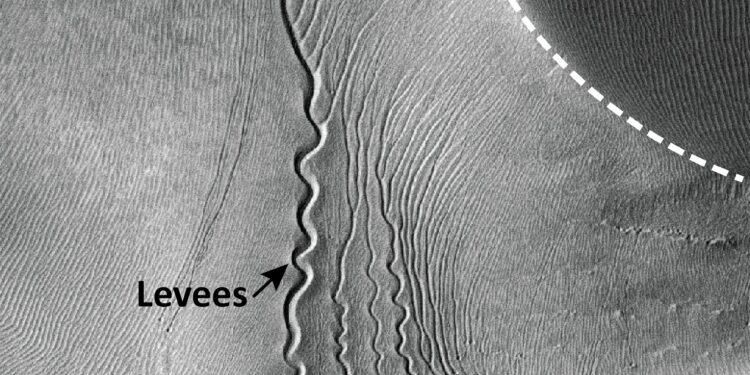Mars dune with gullies in the Matara crater. The uneven course is likely due to disturbances such as wind ridges in the sand bed, sending the blocks in a different direction each time. Pits at the bottom of the slope mark the end of the process. Credit: Image taken by HiRISE (ESP_030528_1300_RED), NASA/JPL/University of Arizona.
Did life really exist on Mars after all? Unfortunately, there is no conclusive evidence on this yet. However, it seems that a certain form of life is at the origin of the mysterious ravines of the Martian dunes. Earth scientist Dr Lonneke Roelofs from Utrecht University has studied how these ravines formed. In a test setup, she observed that blocks of CO2 the ice “carved” these ravines in a unique way.
“I felt like I was watching the sandworms in the movie Dune,” Roelofs says. Its findings are published in Geophysical research letters.
Other researchers previously suspected that these blocks could play a role in the formation of the gullies. Roelofs has now proven this by making the CO2 blocks of ice carve out these ravines during an experiment – a phenomenon that we are not familiar with here on Earth and which has never been observed by anyone before.
Sublimation
Ice forms on dunes during the Martian winter, when it is minus 120 degrees Celsius. At the end of winter, the slopes of the dunes warm and blocks of ice break away, some up to a meter long. Due to the thin atmosphere and large temperature difference between the hot dune sand and the ice, the underside of the ice immediately turns into gas, a process called sublimation. Since a kilogram of gas requires much more space than the same weight of ice, the ice explodes, so to speak.
“In our simulation, I saw how this high gas pressure propelled the sand around the block in all directions,” says Roelofs. As a result, the block sinks into the slope and becomes trapped in a hollow surrounded by small ridges of deposited sand. “However, the sublimation process continues and sand continues to be thrown in all directions.”
Due to this process, the block gradually descends, leaving behind a long, deep ravine with small sand ridges on either side. This is exactly the type of ravine that is also found on the red planet.
Lonneke Roelofs studies the processes that shape the landscape of the planet Mars. For example, last year she published her research on CO sublimation2 ice as the driving force behind Martian debris flows. These flows carve deep ravines on the walls of the crater.
“But the gullies resulting from this research were different,” says Roelofs. “So there was a different process behind it, but what was it? That’s what I decided to find out.”
Martian Chamber
Together with master’s student Simone Visschers, she traveled to the English town of Milton Keynes to solve the mystery behind these unusual sand gullies. The Open University has a “Martian chamber”: a facility for simulating Martian conditions.
-
The configuration prior to the experiment in the Mars Chamber. Credit: Lonneke Roelofs/Utrecht University
-
Dr. Lonneke Roelofs prepares her experiments in the Mars Chamber. Credit: Lonneke Roelofs/Utrecht University
“We experimented with different things by simulating a dune slope at different tilt angles. We left a block of CO2 the ice fell from the top of the slope and I observed what was happening,” explains the researcher. “After finding the right slope, we finally saw results. The CO2 a block of ice began to sink into the slope and move downhill, just like a burrowing mole or the sandworms of Dune. It looked very strange. »
But how exactly do these blocks of ice form? “The CO2 Blocks of ice form on desert dunes midway in the southern hemisphere of Mars. During the winter, a layer of CO2 ice forms over the entire surface of the dune field, sometimes up to 70 cm thick. In spring, this ice begins to warm up and sublimate.
“The last remnants of this ice are on the shaded side of the dune tops, and this is where the blocks break away once the temperature is high enough. Once the blocks reach the bottom of the slope and stop moving, the ice continues to sublimate until all the CO2 evaporated. What remains is a hollow in the sand at the foot of the dune,” Roelofs explains.
Mars dune with gullies in Russell Crater. On the way down, the ice blocks raised dikes. Credit: Image taken by HiRISE (PSP_001440_1255_RED), NASA/JPL/University of Arizona.
Why Mars?
Why does this planet fascinate people so much? “Mars is our closest neighbor. It is the only rocky planet close to the ‘green zone’ of our solar system. This zone is exactly far enough from the sun to allow the presence of liquid water, a prerequisite for life. Questions about the origin of life, and possible extraterrestrial life, could therefore be answered here,” explains Roelofs.
“Additionally, conducting research into the formation of landscape structures on other planets is a way to step outside of the frameworks used to think about Earth. It allows you to ask slightly different questions, which in turn can provide new insights into processes here on our planet.”
More information:
Lonneke Roelofs et al, CO sliding and burrowing blocks2 Create sinuous “linear dune ravines” on Martian dunes by sublimation-induced explosive particle transport, Geophysical research letters (2025). DOI: 10.1029/2024gl112860
Provided by Utrecht University
Quote: Mysterious ravines on Mars appear to have been carved by burrowing CO₂ ice blocks (2025, October 14) retrieved October 15, 2025 from
This document is subject to copyright. Except for fair use for private study or research purposes, no part may be reproduced without written permission. The content is provided for informational purposes only.



